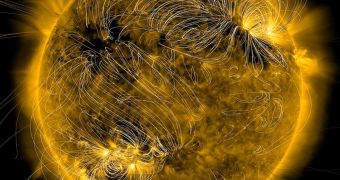Data taken on August 20 by the Helioseismic and Magnetic Imager instrument (HMI), along with a new image from the Solar Dynamics Observatory, allowed the tracing of a complex network of magnetic fields in the Sun's corona, linked to a coronal hole that is now turning to face Earth.
Coronal holes are the large areas in the corona that are darker, less dense and cooler that the surrounding regions, and the open structure or their magnetic field allows continuously to high-density plasma to flow out of the holes.
The Sun is just emerging from a solar minimum and coronal holes are mainly at its polar regions, but they can be anywhere during the solar maximum, and as a coronal hole faces Earth, there I an increase in the solar winds effects on our planet.
In this HMI image, magnetic field lines are color coded - white lines are for closed fields that do not release solar winds and gold ones are for open fields that let solar wind escape.
Much of the structure of the Sun's corona is shaped by magnetic field and although it varies in time and place of the star's surface, it can be very strong, like inside sunspots for example, where it can reach several thousand times the strength of the Earth's magnetic field.
The Solar Dynamics Observatory (SDO) is the first satellite of the Living With a Star (LWS) Program at NASA and it was designed to fly for five years.
It was launched on February11, 2010 at 10:23:00 am EST aboard a United Launch Alliance Atlas V rocket from Launch Complex 41 at Cape Canaveral Air Force Station, Florida.
The SDO is constantly looking at the Sun, as it is the source of all Space Weather, that affects life on Earth, the planet itself as well as everything outside the atmosphere.
The satellite should help understand where does the Sun's energy come from, what's the Sun's inner mechanism and the way the energy is stored and released into the atmosphere.
Having a better knowledge on the Sun will help better predict and forecast the “weather out in space” and protect the astronauts and satellites orbiting the Earth.
The HMI analyzes the magnetic field at the solar surface and it is one of the three instruments on the Solar Dynamics Observatory.
HMI succeeds the Michelson Doppler Imager on the Solar and Heliospheric Observatory, reports Space Fellowship.
Learn more about magnetic field lines and the SDO’s HMI instrument in this video from SDO:

 14 DAY TRIAL //
14 DAY TRIAL //